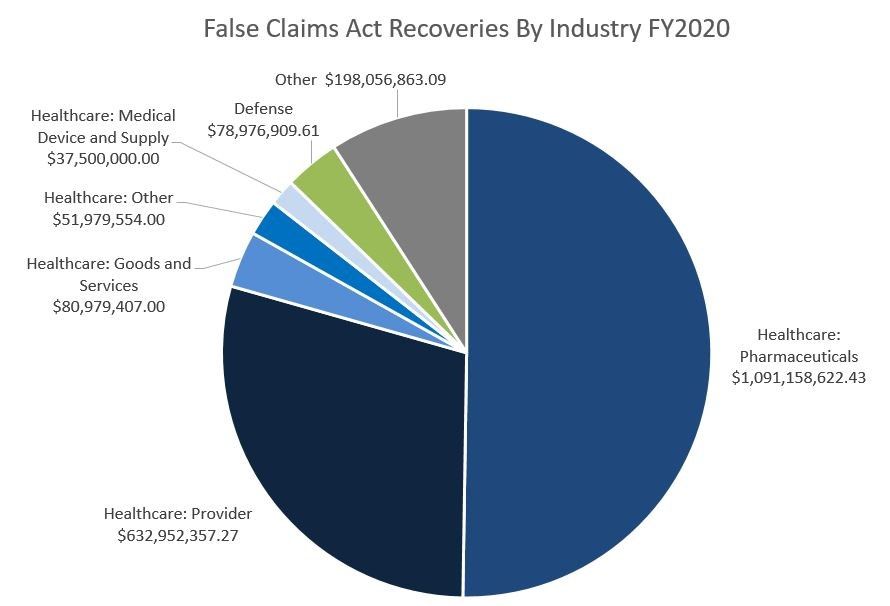Fiscal Year 2020 is now in the books, and, by our count, the Department of Justice recovered just shy of $2.2 billion from False Claims Act actions over that period. We will check our work when DOJ publishes its annual FCA statistics, but our analysis shows that the 2020 recoveries represent a significant drop off from recent years, and resulted in the lowest amount recovered in any year since FY 2008. This was not unexpected, given both the disruption brought on by COVID-19 and the historically low number of recoveries in the first half of this fiscal year before the pandemic emerged. However, the decrease does not appear to result from a decrease in enforcement actions, which have remained relatively consistent year-over year. Rather, the dip seems to be caused by FY 2020's significant drop off in "blockbuster" recoveries, with only two recoveries eclipsing $100 million. That being said, recoveries picked up substantially in the fourth quarter of the fiscal year, representing nearly two thirds of the year's total dollars recovered. As is often the case, there was an uptick in settlements leading up to the close of the fiscal year with 21 of settlements and nearly $270 million recovered in the month of September—more than the total amount recovered in the entire second quarter of this year. Whether the Q4 spike will become a trend with recoveries continuing at this pace into FY 2021 has yet to be seen.
Notably, the top six recoveries of FY 2020 in terms of dollar amounts occurred in Q4. The year's largest recovery was a joint settlement arising out of actions in the District of Massachusetts and Southern District of New York, announced in July, which recovered $642 million from a pharmaceutical company. The next largest recovery brought in $209 million from a pharmaceutical company resulting from actions brought in the District of New Jersey and the Western District of Virginia. These two recoveries, however, represent significant outliers from the rest of the fiscal year's recoveries, none of which eclipsed $100 million.
Healthcare remained the focus of the DOJ's efforts, representing 87.2% of all recovery dollars in the fiscal year. Recoveries from the pharmaceutical industry represented 50.2% of the annual total, and healthcare provider-related actions represented 29.1%. The healthcare industry was also DOJ's primary focus in terms of the total number of actions brought, representing 167 of the 226 actions resolved this fiscal year. As is typical, actions against healthcare providers made up the majority of these actions (120 total), although that amount represents a higher proportion compared to what we have seen in recent years.
Outside of the healthcare industry, the DOJ's efforts focused primarily on government and defense contractors, and the two largest non-healthcare recoveries arose from actions involving the Department of Energy. The largest, bringing in nearly $58 million, was a matter out of the Eastern District of Washington alleging that a DOE contractor overcharged the department for billing time not worked between 2009 through 2019. The second largest was brought in the District of Columbia and resulted in a $29 million recovery, alleging that the purchaser of a DOE loan engaged in bid rigging.

Comparing this year's results to years past, the total amount of enforcement actions brought appear surprisingly consistent. This year's total, 226 actions resolved, is actually one action more than the department's total last year (225 in FY 2019) and higher than the total for FY 2018, which saw 212 actions resolved. What appears to be driving the difference in dollars recovered, though, is the absence of significant "blockbuster" recoveries, which we consider actions recovering more than $100 million. In FY 2019, there were six such recoveries, representing more than half of the total recoveries for that period. And FYs 2016-2018 show similar trends, each having a small number of blockbuster recoveries driving more than half of the total amount recovered. FY2020 is an outlier in this regard, having just two blockbuster recoveries. FY 2020 did not see any significant changes in terms of the average amount recovered from non-blockbuster cases.
Similarly, there were no significant changes in the way cases were brought or resolved. Qui tam actions comprised a small majority of total recoveries in FY 2020 (124 of 226) but more than 81% of all dollars recovered, similar to what we have seen in prior years. Settlements again composed the vast majority of matters and dollars recovered, with trial judgments representing just a small sliver of both the total number of actions and dollars recovered.
Thus, despite the many disruptions and abnormalities of 2020, the overall enforcement trends of the past few years continued through FY 2020, albeit resulting in fewer total dollars recovered. Looking forward to FY 2021, we do expect to see a shift in the DOJ's enforcement efforts, as it adds to its focus areas claims related the CARES Act and other COVID-19-related relief programs. Indeed, DOJ Principal Deputy Assistant Attorney General Ethan P. Davis outlined earlier this summer the department's focus and priorities for CARES Act-related enforcement, though this may not result in an immediate, marked increase in recoveries given the often long periods of time that it takes for a new case to result in a recovery, particularly if brought by a relator. And, of course, the next fiscal year may involve a change in administrations, which may alter enforcement priorities.
The content of this article is intended to provide a general guide to the subject matter. Specialist advice should be sought about your specific circumstances.
